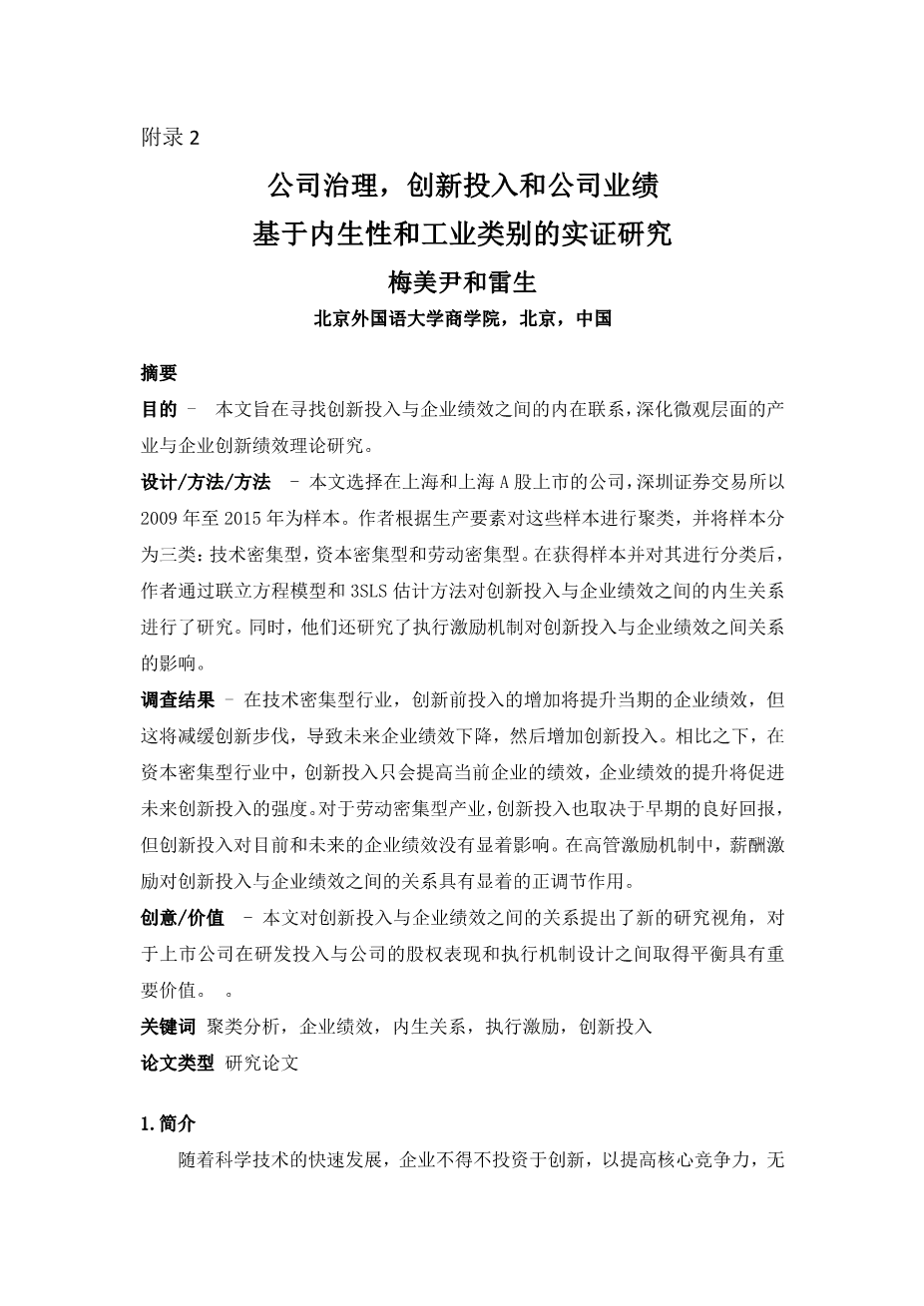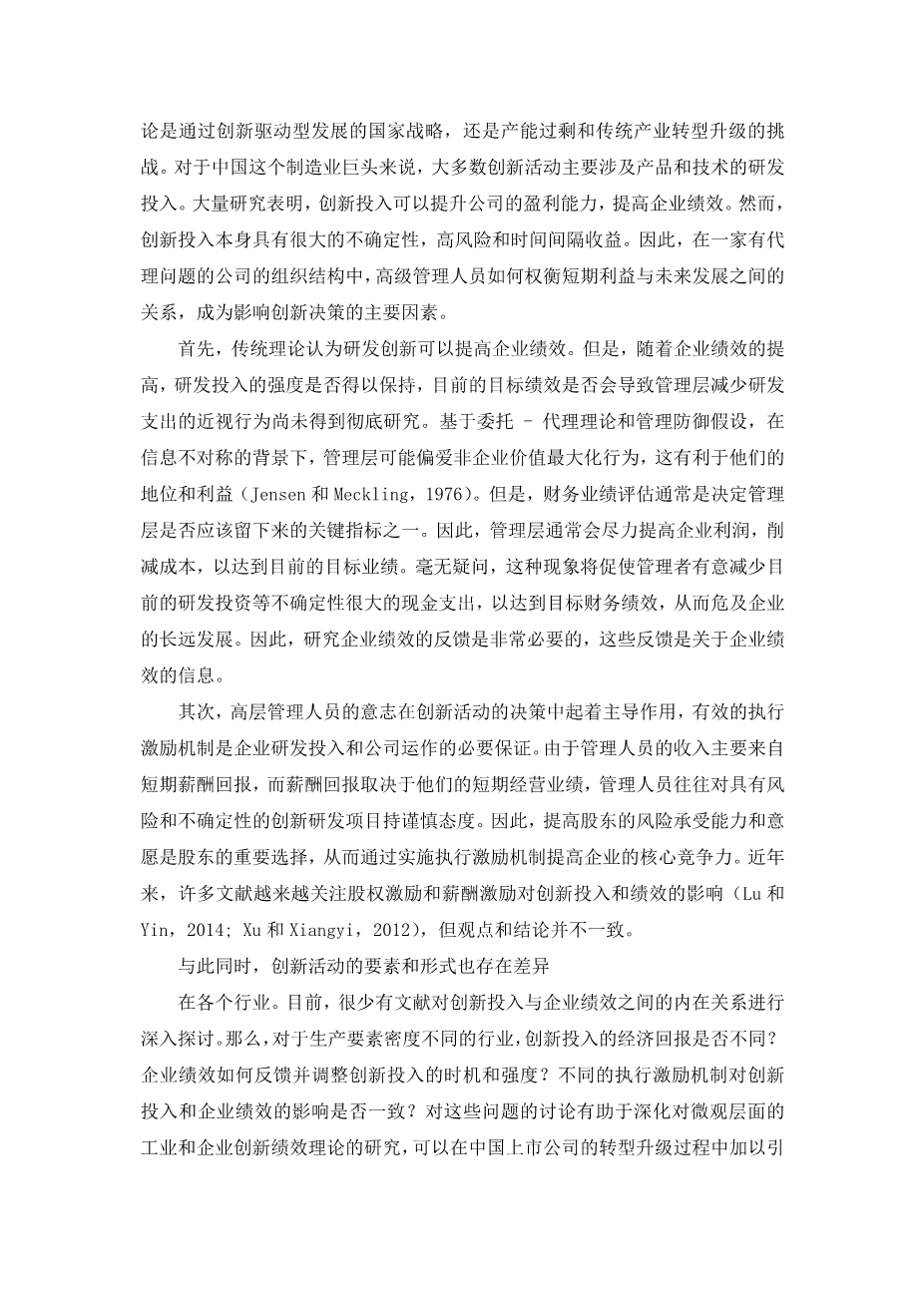附录1:
input and corporate performance
Empirical research based on endogeneity and
industry categories
Meiqun Yin and Lei Sheng
Business School, Beijing International Studies University, Beijing, China
Abstract
Purpose – This paper aims to find the endogenous relationship between innovation input and corporate performance and deepen the study of innovation performance theory in industry and enterprise at the micro level.
Design/methodology/approach – This paper selects the firms listed on A shares in Shanghai and Shenzhen Stock Exchanges from 2009 to 2015 as samples. The authors cluster these samples according to the factors of production and classify the samples
into three types: technology-intensive, capital-intensive and labor-intensive. After obtaining the samples and classifying them, the authors conduct a research on the endogenous relationship between the innovation input and the corporate performance through the simultaneous equations model and 3SLS estimation method. Meanwhile, theyalso make a study on the influence of executive incentive mechanism on the relationship between the innovation input and the corporate performance.
Findings – In technology-intensive industry,the increase of pre-innovation input will enhance the corporate performance in the current period, however, which will slow down the pace of innovation and lead to lower corporate performance in the future, and then increase innovation input again. In contrast, in capital-intensive industries, innovation input just improves corporate performance in the current period and the promotion of corporate performance will promote the intensity of innovation input in the future. With labor-intensive industries, innovation input also depends on early good returns, but innovation input has no significant impact on the corporate performance both at present and in the future. While in the executive incentive mechanism, salary incentive has a significant positive rateegulatory effect on the relationship between innovation input and corporate peformance.
Originality/value – This paper presents a new research perspective on the relationship between Innovation input and firm corporate performance, which is of great value to the listed company in balancing the Ramp;D input with the companyrsquo;s target performance and the design design of executive in centive mechanism.
Keywords Cluster analysis, Corporation performance, Endogenous relationship, Executive incentive, Innovation input
Paper type Research paper
1. Introduction
As science and technology are evolving rapidly, companies are compelled to invest in innovation to enhance their core competitiveness, whether through the national strategy of innovation-driven development,or the challenges of excess capacity and transformation and upgrading of traditional industries. For most companies in China, a manufacturing powerhouse, most of innovation activities mainly involve Ramp;D investment in products and technology. A large number of studies have shown that innovation input can promote the companyrsquo;s profitability and improve the corporate performance. However, the innovation input itself is characterized by great uncertainty, high risk and inter temporal earnings. Therefore, in the organizational structure of a company with agency problems, how senior managers weigh the relationship between short-term benefit and future development becomes the main factor influencing the innovation input decision.
First,traditional theories believe that Ramp;D innovation can improve corporate performance. However, with the improvement of corporate performance, whether the intensity of Ramp;D investment can be maintained and whether the current target performance will lead to the myopic behavior of the management to reducing Ramp;D expenditurehas not been studied thoroughly. Based on the principal-agent theory and the management defense hypothesis, in the context of information asymmetry, the managementmay favor the non-corporate value maximization behavior, which benefits their position and interests (Jensen and Meckling, 1976). However, financial performance assessment is often one of the key indicators to decide whether the management should stay.Therefore, the management will usually try their best to increase corporate profits and cut costs so as to achieve the current target performance. Undoubtedly, this phenomenon will induce managers to intentionally reduce the current cash expenditures with large uncertainties, such as Ramp;D investment, to meet the target financial performance, thus jeopardizing the long-term development of enterprises. Therefore, it is very necessary to study the feedback of corporate performance on its innovation input asthe endogenous relationship between the two.
Second, the will of top management plays a leading role in the decision-making of innovation activities, and an effective executive incentive mechanism is the necessary guarantee for enterprise Ramp;D investment and company operation. As the income of managers mainly comes from short-term remuneration returns, while remuneration returns depend on their short-term operating performance, managers are often wary of innovative Ramp;D projects with risk and uncertainty. Therefore, it is an important choice for shareholders to improve risk-bearing capacity and willingness of senior managers, thereby increasing the core competitiveness of enterprises through the implementation of executive incentive mechanism. In recent years, many literatures have been increasingly focusing on the impact of equity incentive and salary incentive on innovation input and performance (Lu and Yin, 2014; Xu and Xiangyi, 2012), but the perspectives and conclusions are not c
剩余内容已隐藏,支付完成后下载完整资料


英语译文共 18 页,剩余内容已隐藏,支付完成后下载完整资料
资料编号:[609891],资料为PDF文档或Word文档,PDF文档可免费转换为Word
以上是毕业论文外文翻译,课题毕业论文、任务书、文献综述、开题报告、程序设计、图纸设计等资料可联系客服协助查找。


